Saber Astronautics gains funds to improve space operations software

Saber Astronautics which is a key part of future Australian space missions including a role in NASA’s Moon to Mars project, has won US funding to improve its space operations capabilities.
The company, which operates the Responsive Space Operations Centre (RSOC) in Adelaide and a Space R&D laboratory in Sydney, has won a $540,000 award as a part of the Tactical Funding Increase (TACFI) Program of the US Air Force.
The TACFI award supports the further development and refinement of Saber’s space operations software, Space Cockpit, which is deployed on non-classified and Secret Internet Protocol Router Networks utilised by US warfighters.
Space Cockpit’s original development was based on Saber Astronautics’ PIGITM software, a space operations software used by the Responsive Space Operations CenterTM (RSOC) in Colorado and Australia.
PIGI is used to send commands and receive telemetry to spacecraft through a network of commercial ground station and sensor providers.
The TACFI Program is managed by by AFWERX, the innovation arm of the US Department of Air Force (US DAF), with the funding following initial support awarded to Saber Astronautics in 2019.
Director of Saber Astronautics USA Nathan Parrott said: “Normally the government buys software and that’s the end of it.
“But modern warfare, especially in space, is very dynamic.
“We needed the ability to update the programme on the fly to respond to the rapidly evolving threat landscape. We may know what features (US operators) need today, but what about tomorrow?”
Saber is able to update Space Cockpit in parallel to developing needs with direct, continuous feedback from operators themselves.
This ability to quickly and continuously upgrade software is a key benefit to users.
The most recent improvements deployed to warfighters include an upgrade to the orbit propagation algorithms supporting CisLunar spaceflight, charting spacecraft orbit states and observations, and the ability to execute spacecraft maneuvers.
The number of users of Space Cockpit doubled in the last two months, with hundreds of operators across multiple units in the US.
Saber Astronautics CEO Dr Jason Held said: “Space Cockpit, especially the visualization features, are going a bit viral within the Space Force community.
“Each unit has their own special needs so we developed a framework in Space Cockpit to allow rapid changes. Embedding flexibility in the software is empowering for operators to directly impact the product they use every day.”
Picture: South Australian Space Industry Centre/Saber Astronautics mission control, Adelaide
Topics Manufacturing News Technology
@aumanufacturing Sections
Analysis and Commentary Awards Defence Manufacturing News Podcast Technology Videos






